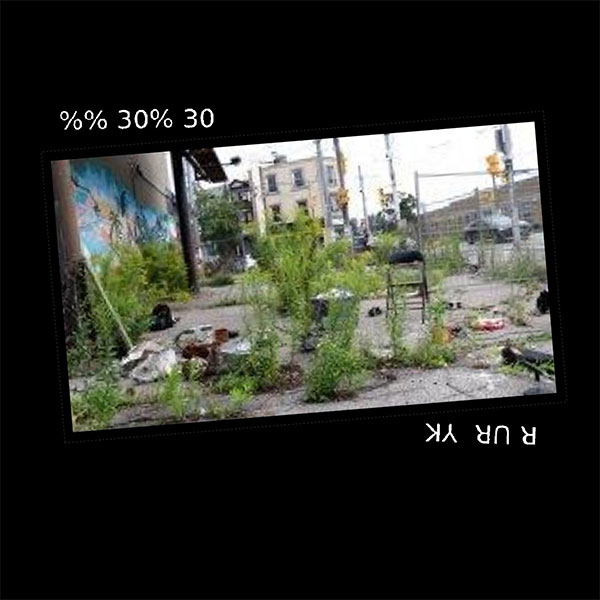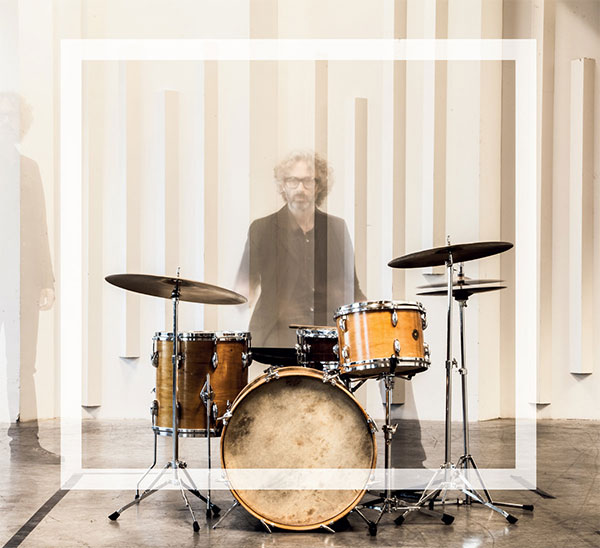
Outside, Brian Ruryk / %%30%30 (Scatter Archive)
Here, Steve Argüelles (Steve Argüelles)
The recent Scatter Archive release, Outside, documents a series of outdoor performances made by Toronto-based performers Brian Ruryk and Colin Cudmore (aka %%30%30) in 2023 and 2024. Ruryk (whose album Coughs I reviewed here not long ago) is an experimental guitarist who has been making music out of noise since the 1980s (imagine if Sam Brakhage, instead of making films, had prepared guitars, made field recordings and processed noise with lo-fi cassette recorders and you’ll begin to get the idea). Cudmore is a percussionist, improviser and performance artist. The performances took place at a variety of outdoor locations around Toronto. Both performers are billed as playing ‘detritus’. Ruryk also brought along his guitar.
Listening to the first track – ‘Dundas Lansdowne’ – I was struck by how traditional this music can sometimes sound. Although the sound-world is fiercely unconventional, the rise and fall of the sound and the use of gestures (for example, the striking opening sound, which gains our attention) often can’t help but recall more conventional musical styles. To look at it another way, when one makes music out of material that’s not usually considered musical, it’s interesting to see what features of more conventional music are retained. At one end of the scale, people have tried to force ‘non-musical’ sounds to behave musically, carefully scoring typewriters and sirens into their work, while at the other – as in John Cage’s 4’33” – sounds have simply been allowed to happen. (Cage came to distrust improvisation, as he felt that if musicians followed their intuition, they would indeed come up with conventional musical shapes). Between these two extremes lies a world of intriguing possibilities. And if all sounds are admissible that means sounds can sometimes admit themselves. The fortuitous car horn that butts in at 4:16 in that first track could not have been better placed. As it says in the album notes, one can almost think of these performances as trios, rather than duets, the third performer being the players’ surroundings.
There is, of course, a sense of playfulness at work. And playful, of course, is what all music is. The clue is in the first four letters. I think it’s fair to say we usually think of the word ‘play’ as having two meanings: when we talk of ‘playing the guitar’ we think we’re using the word to mean something very different from when we talk of ‘playing in the yard’. However, this is not the case. You could say Ruryk and Cudmore are ‘playing’ or ‘playing with’ a guitar and a pile of junk. Both are true. And one should not forget that play has its dark side. The fact that it can absorb and amuse means it can lure us in. There was a moment, in YYZ1, when I was suddenly struck by the bleakness of it all: two men playing, like toddlers almost, among the wreckage of a consumer society under the flightpath of passenger jets, as if they were lost and a little overwhelmed, seeking meaning in the noise things make, in much the same way as early peoples probably sought meaning by drawing pictures of their world on cave walls.
In the middle of the seventh track (‘Bickford 1’) people who’d stopped to listen break into spontaneous applause. I can understand why. There is an engaging intensity to these recordings which leaves you feeling you wish you’d been there. A great listen.

If you’re a jazz fan, you’ll probably be familiar with the work of British drummer Steve Argüelles. He grew up in Birmingham and, at the tender age of sixteen, landed himself the job of house drummer at Ronnie Scott’s. He went on to be a part of the 1980s jazz orchestra, Loose Tubes, the first such orchestra to play at the BBC Proms and, for a while, played with Django Bates’ jazz quartet, Human Chain. He’s recently released a solo album, Here. If you’re one of the many people who harbour misgivings about solo drum albums, I’d say set them aside in this case and give it a chance (if you need a sweetener, there are four tracks where he duets with other musicians).
The first track on the album, ‘Improvisations that speak with admirations’, is proof – if you feel a need for it – that a lone drummer doesn’t need to revert to pyrotechnics to be interesting to listen to. This is subtle, understated music that makes for compulsive listening. Argüelles makes up for the fact that he has no pitched notes at his disposal with his total creative control of all the other musical parameters: he draws a rich variety of timbres from his kit (if you’ve ever wondered how many different sounds you can get out of a cymbal, listen to ‘Looped unlooped’ and try counting them). Indeed, he gets at least a much out of his kit as a good sax player, armed with two and a half octaves of notes, gets out of a sax or, to put it another way, as Ludovico Granvassu says in the album notes, he ‘plays the drums as if it were a piano, with an attention to its melodic aspects as much as to its rhythmic ones.’
It’s great to hear him duetting with recordings of Coxhill, Lacy and Wheeler, although ‘Here for Lee Koonitz’ was probably my favourite of the duet tracks. It’s so easy, in one’s mind, to push ‘the drums’ into the background, to keep the ‘front line’ instruments at the forefront of ones attention. However, listening to the preceding solo tracks really opens the ears – if they need opening – to what the drums can do. These duets are conversations between equals and, if you are a solo drum cynic who started the album looking forward to the duet tracks, thinking they’d provide respite, you might be surprise to find your ears are still focussed on Argüelles.
.
Dominic Rivron
LINKS
Outside: https://scatterarchive.bandcamp.com/album/outside
Here: https://stevearguelles.bandcamp.com/album/here
.
